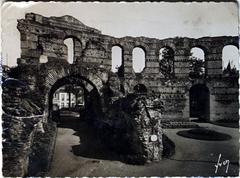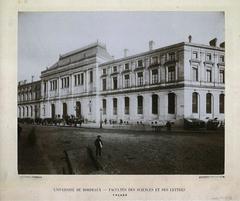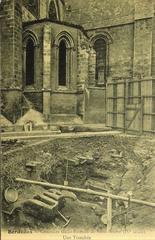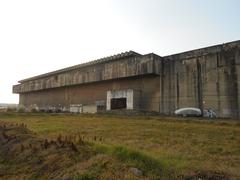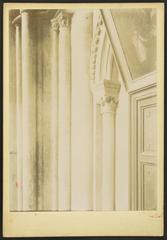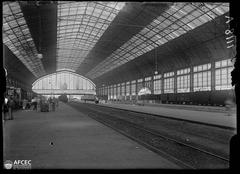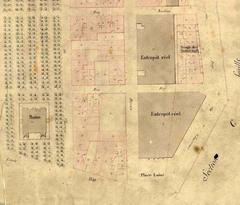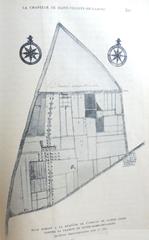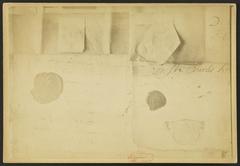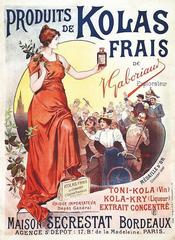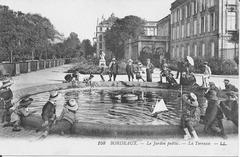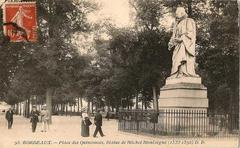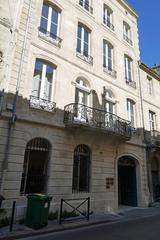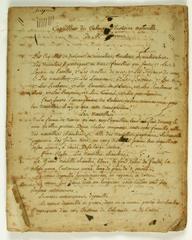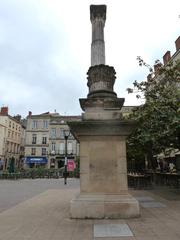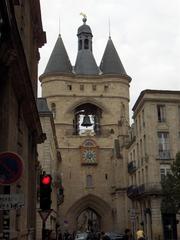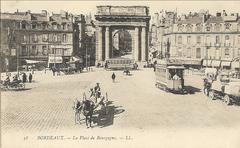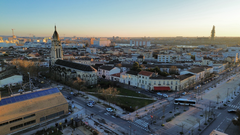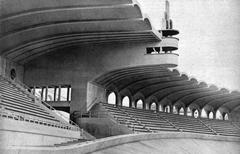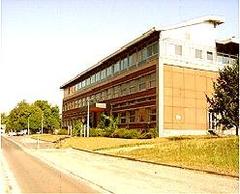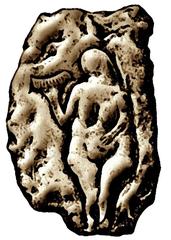Chartreuse Le Caoulet Bordeaux, France: Visiting Hours, Tickets, and Travel Guide
Date: 14/06/2025
Introduction
Chartreuse Le Caoulet is a rare gem in Bordeaux’s architectural and viticultural landscape. Located in the Graves district, an area synonymous with Bordeaux’s wine legacy, this 18th-century chartreuse offers a window into the refined lifestyle of the region’s historic wine aristocracy. While the word “chartreuse” might recall monastic buildings elsewhere in France, here it refers to an understated yet elegant single-storey country house—an emblem of Bordeaux’s unique blend of social prestige and practical vineyard management (Wikipedia: Chartreuse (maison)). Chartreuse Le Caoulet’s harmonious proportions, classical restraint, and seamless integration with the landscape make it a compelling stop for anyone interested in history, architecture, or wine culture.
This guide provides a comprehensive overview of Chartreuse Le Caoulet’s history, architecture, visiting information, travel tips, and its place among Bordeaux historical sites.
Historical Context of Chartreuse Le Caoulet
Chartreuse Le Caoulet was designed by Jean Chalifour in the late 1700s, during Bordeaux’s economic golden age. The building exemplifies the regional “chartreuse” style: a single-storey, nearly square residence with an elevated main floor and a basement optimized for wine storage (Monumentum). The Graves district, known for its “vin de ville,” was a coveted address for Bordeaux’s elite, who sought both social status and practical proximity to their vineyards (Gralon).
Ownership of such a property signified not only wealth, but also a deep connection to Bordeaux’s wine-producing tradition. The architectural form—horizontal, symmetrical, and constructed from luminous local limestone—reflects both the functional needs and the aesthetic tastes of the period (POP Culture Gouv).
Architectural Features and Preservation
Chartreuse Le Caoulet’s design demonstrates the Bordeaux chartreuse’s hallmarks:
- Single-storey layout with a raised ground floor (to protect from dampness and flooding)
- Basement/cellar dedicated to wine storage and service areas
- Symmetrical façade constructed from finely dressed local limestone
- Central entrance highlighted by classical elements such as pilasters and molded arches
- Large windows and French doors opening onto a terrace
- Historic portal and enclosure that add privacy and prestige
The chartreuse, its portal, and enclosure were designated a Monument Historique on March 6, 2009, ensuring their preservation as part of Bordeaux’s architectural heritage (POP Culture Gouv). This status protects their historical authenticity and underscores their cultural value within Bordeaux’s UNESCO-listed urban landscape.
Visiting Information: Hours, Tickets, and Access
Chartreuse Le Caoulet is a private residence, meaning regular public access is not available. There are:
- No fixed visiting hours
- No ticket sales for individual visitors
- Occasional public openings during special events, such as European Heritage Days (Journées Européennes du Patrimoine), usually in September
To stay informed about opportunities to visit, check the official Bordeaux Tourism website or contact the Bordeaux Office of Tourism. On open days, guided tours may be available, typically free or at nominal cost.
Accessibility and Travel Tips
- Address: 29 Rue Theresia Cabarrus, 33800 Bordeaux
- Access: The site is within walking distance of central Bordeaux and well-served by public transport (Tram Line A, multiple bus routes).
- Viewing: The exterior, including the façade and portal, can be admired from the street year-round. Please respect the private status of the property.
- Accessibility: Due to the historic nature, wheelchair access may be limited. Inquire with organizers during special openings.
Combine your visit with a stroll through the Graves district or nearby vineyards to experience Bordeaux’s wine heritage.
Nearby Attractions and Bordeaux Historical Sites
While in the area, consider visiting:
- Place de la Bourse: Bordeaux’s iconic 18th-century square
- Jardin Botanique: Beautiful botanical gardens
- Musée d’Aquitaine: Comprehensive regional history museum
- Cité du Vin: Modern wine museum and tasting venue
- Grand Théâtre de Bordeaux: Architectural and cultural landmark
For those passionate about the chartreuse style, notable examples include Chartreuse de Mirande and Chartreuse de Fontcastel (Musée du Patrimoine de France).
Accommodation Options
Stay close to Chartreuse Le Caoulet at well-rated hotels and guesthouses such as:
- La Maison du Lierre
- Grand Hôtel de Bordeaux & Spa
- Hôtel de Sèze
- La Cour Carrée
- Hôtel Bordeaux Clemenceau
- La Chartreuse-Bordeaux for a boutique guesthouse experience (Chartreuse Bordeaux)
Visitor Tips
- Best time to visit: Spring and fall for mild weather and fewer crowds; summer for vineyard tours (note some wineries close during harvest in September) (Salt in Our Hair)
- Events: Watch for Bordeaux Fête le Vin in June and European Heritage Days in September (Bordeaux Tourism Agenda)
- Transport: Consider the Bordeaux CityPass for unlimited travel and discounted entry to attractions (Bordeaux CityPass)
- Guided Tours: Book in advance through the Bordeaux Tourist Office (Bordeaux Tourism)
Chartreuse Le Caoulet in Bordeaux’s Heritage
Chartreuse Le Caoulet is emblematic of Bordeaux’s integration of rural and urban life, where wine production, architecture, and social status intersect. Its preservation as a Monument Historique is part of a broader commitment to maintaining the city’s historic diversity (Monumentum). The chartreuse’s proximity to both the city center and the Graves vineyards uniquely situates it as a bridge between Bordeaux’s past and present.
Frequently Asked Questions (FAQ)
Q: Can I visit Chartreuse Le Caoulet year-round?
A: No, access is generally limited to special events like European Heritage Days.
Q: Are tickets required?
A: Not for regular visits, as there are none. Special events may require advance booking or free registration.
Q: Is the site wheelchair accessible?
A: Accessibility may be limited; check with event organizers.
Q: Are there guided tours?
A: Occasionally, during special openings.
Q: Can I take photos?
A: Yes, from public areas. Please respect the privacy of residents.
Preservation and Heritage Status
The chartreuse, portal, and enclosure are protected as a Monument Historique since 2009 (POP Culture Gouv). This ensures careful preservation and limits modifications, contributing to Bordeaux’s UNESCO World Heritage appeal.
Further Resources and Official Links
- Monumentum: Chartreuse Le Caoulet
- Wikipedia: Chartreuse (maison)
- Gralon: Chartreuse Le Caoulet
- POP Culture Gouv: Chartreuse Le Caoulet
- Bordeaux Tourism Official Website
Final Thoughts and Call to Action
Chartreuse Le Caoulet stands as an enduring symbol of Bordeaux’s wine heritage, architectural elegance, and social history. While access is limited, its preservation and occasional public openings provide rare insights into a pivotal era of Bordeaux’s development. For a full experience, explore the surrounding historic sites, enjoy local wine tours, and use digital resources like the Audiala app for up-to-date information on cultural events and heritage visits.
Plan your Bordeaux adventure today—immerse yourself in the city’s historic charm, and witness how Chartreuse Le Caoulet anchors Bordeaux’s identity as a world wine capital.
Sources
- Chartreuse Le Caoulet: Visiting Hours, Tickets, and Guide to a Bordeaux Historical Site, 2024, Monumentum (Monumentum)
- Exploring the Architectural Heritage of Chartreuse Bordeaux: Visiting Hours, Tickets, and More, 2024, Wikipedia (Wikipedia: Chartreuse (maison))
- Chartreuse Le Caoulet in Bordeaux: Visiting Hours, Tickets, and Historical Insights, 2024, Gralon (Gralon)
- Chartreuse Le Caoulet Visiting Hours, Tickets & Bordeaux Historical Sites Guide, 2024, POP Culture Gouv (POP Culture Gouv)
- Bordeaux Tourism Official Website, 2024 (Bordeaux Tourism)
